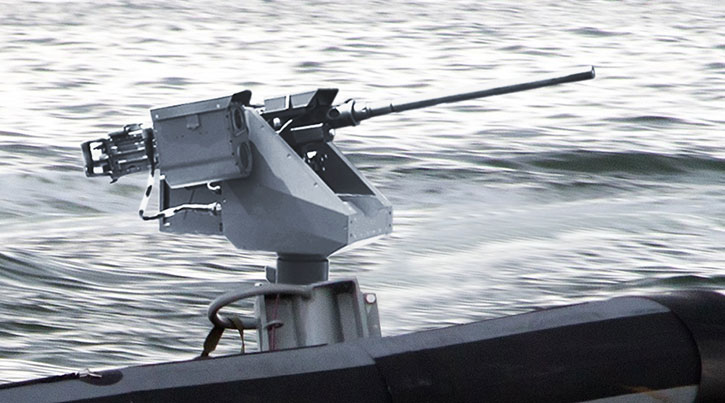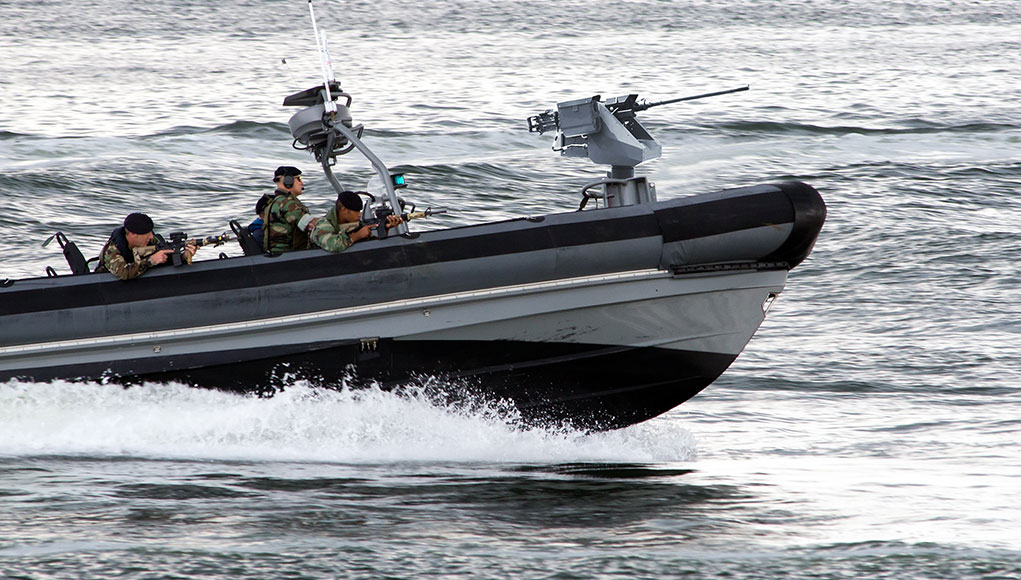 Naval commandos rely on stealth and surprise to get close to the enemy, strike swiftly, and disengage. For these attributes, they rely on submersible vehicles or Rigid Hull Inflatable Boats – RHIB, small and fast boats, to bring them close to the target with the firepower they need. However, due to the size of these boats, naval commandos cannot use many of the sophisticated weapons employed on larger platforms. That is precisely where General Robotics’ new SHARK Remotely Controlled Weapon Station (RCWS) comes into effect.
Naval commandos rely on stealth and surprise to get close to the enemy, strike swiftly, and disengage. For these attributes, they rely on submersible vehicles or Rigid Hull Inflatable Boats – RHIB, small and fast boats, to bring them close to the target with the firepower they need. However, due to the size of these boats, naval commandos cannot use many of the sophisticated weapons employed on larger platforms. That is precisely where General Robotics’ new SHARK Remotely Controlled Weapon Station (RCWS) comes into effect.
SHARK addresses the need for SOF to operate their weapons on small boats. These compact boats move at high speed and agility. Yet, the constantly moving platform degrades fire accuracy with conventional weapon mounts, requiring operators to get dangerously close to the enemy to deliver the desired effects. Crews on larger boats often operate stabilized weapon stations to improve fire accuracy, but these systems are much larger and heavier for RHIBs. To meet this challenge, General Robotics has introduced the SHARK, a unique RCWS that applies to naval roles, from special operations to law enforcement interception, including interception, coastal security, counter-terror, and anti-piracy activities.
“We designed SHARK to meet the specific requirements of naval commandos and SEALS,” Shahar Gal, General Robotics’ CEO, said. Addressing the most demanding needs of Naval Special Warfare (NSW), SHARK was designed and tested with users and experts from the local and international NSW community. SHARK fits on small manned and unmanned naval vessels, NSW boats, and raiding crafts to deliver versatile and accurate firepower. At a net weight of 85 kg (without weapons or ammunition), SHARK is much lighter and smaller than other naval weapon stations. Built as a rugged, robust, seaworthy system, it is versatile enough to operate remotely on a cluttered deck, scoring direct hits at a sea state up to 3, where the platform and targets constantly move.
The new SHARK is based on General Robotics’ combat-proven Pitbull RCWS. “We developed the SHARK prototype as a robust yet lightweight system offering seamless remote operation by a single operator with some special adaptations for naval use and NSW concepts of operation,” Gal said, adding that the prototype was further refined based on feedback from our customers and partners following extensive field trials, further maturing SHARK for fielding.

SHARK uses dual-axis electro-mechanical stabilization coupled with automatic tracking, video motion detection, and fire control for accurate weapon laying to deliver fast and precise firepower. This feature improves its capability to compensate for motions induced by the sea waves, platform, and target movements to engage moving targets.
But that isn’t all. When the operator presses the trigger, the AI-driven fire control runs a target prediction algorithm to align the projectile’s path and the target’s expected location and points the weapon in that direction. Only then is a burst fired. This technique has demonstrated hit accuracy of about 70 percent. This unique capability enables SHARK to be used as a naval Counter-UAS weapon. The SHARK can be mounted in this role with an optional Anti-Drone Jammer used as a ‘soft kill’ C-UAS.
Weapon control is done locally or remotely through an intuitive touch screen tablet encased in a jacket providing the intuitive operating and safety buttons for the “Point & Shoot” control. Another feature added to SHARK that benefits remote operators is the rear camera, providing the operator with a point of view to assess the weapon status and overcome malfunctions associated with the ammunition, weapon, or mount.
The integration on USV poses additional challenges since the boat’s cluttered deck and constant movement add to a situational awareness complexity, restricting the sectors of fire the weapon can use. SHARK is built for platform-independent operation; it maintains an autonomous situational awareness that includes built-in Anti-Collision functions and multiple Fire Inhibiting Zones (FIZ) and is integrated with other systems onboard. Optional integration with onboard radar enables SHARK to detect and alert hostile fires aimed at the unmanned platform and take responding measures accordingly.
The system’s size, weight, and power (SWaP) make SHARK particularly suitable for Naval Special Warfare (NSW) crafts, RHIB, and other manned or unmanned raiding crafts. It enables the crew to maximize the effect of small caliber weapons such as the 40mm automatic grenade launchers, 0.5″ heavy machine guns, and 7.62mm light machine guns.
As a veteran of Israel’s navy, Gal is accustomed to the marine environment, a knowledge that shaped the system’s design optimization to increase operational flexibility, reduce the size and weight saving, and improve reliability. “At the bottom line, the reduced weight and size derive significant benefits,” said Gal, “It means SHARK can be mounted on smaller boats and handle the recoil loads with less weight and energy. As a result, SHARK consumes less power and delivers higher accelerations, resulting in better accuracy and agility. It can be used as a stand-alone system with its sensors or integrated with other sensors onboard. In this way, we offer tailor-made combat solutions to meet the unique requirements of our customers.”






















